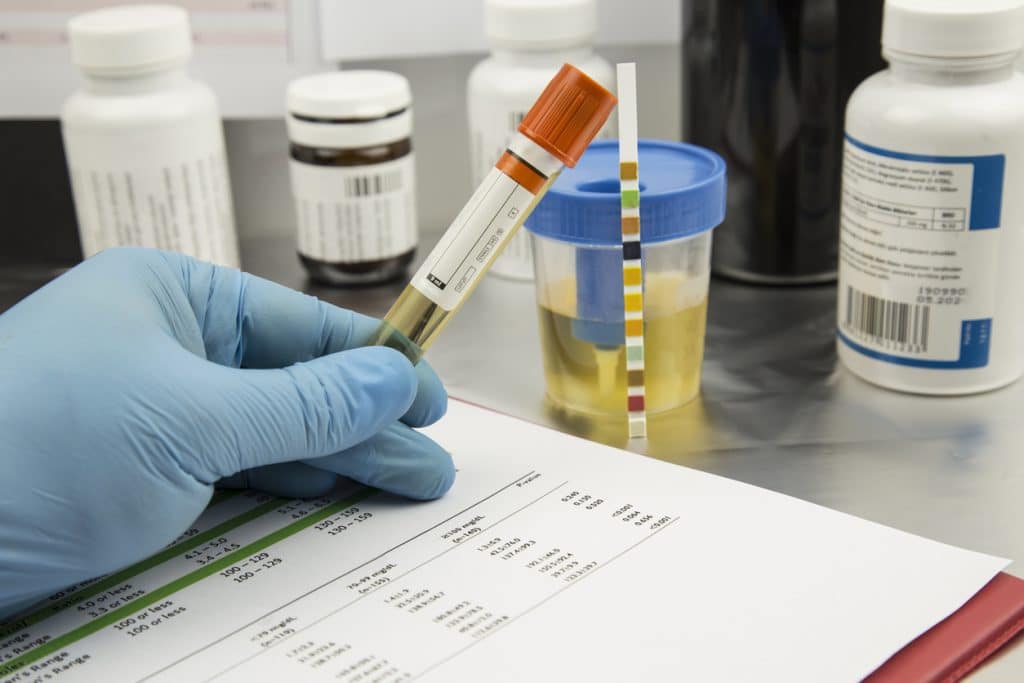- Not a substitute for professional veterinary help.
When your dog has an undiagnosed condition, a urine sample is often what your vet needs to help find the cause of your dog’s discomfort. Urine samples provide vets with a lot of information, include kidney function, white and red blood cells, bacteria, and protein levels. But getting a urine sample is bit more complex than collecting a stool sample.
We do know, however, thanks to Dr. Shannon Barrett, Charleston-based house-call veterinarian and owner of Downward Paws that the best time to collect a urine sample for your dog is first thing in the morning, after their first meal. (Unless otherwise indicated by your veterinarian.)
“Your dog has slept all night and hopefully not urinated throughout the evening. Therefore the first-morning urine will be the most concentrated. This will give us the best information about their urine,” says Dr. Barrett. More concentration makes it easier for the vets to look for bacteria.
The steps involved in collecting a urine sample depend a bit on your dog, but these are the guidelines to follow when collecting a sample. Make sure you:
- have a sterile container
- are collecting the sample at the right time of day
- are able to get a backup
- consider enlisting a friend or partner to assist you in the process
Without any further ado, let’s get into what it takes to get a good dog urine sample with the help and guidance of Dr. Barrett. Read on!
Steps to Collecting a Canine Urine Sample
-
Make sure you have a clean container, preferably a sterile urine cup from your veterinarian. “Small dogs, especially females, tend to squat very low to the ground,” says Dr. Barrett. “In these cases, it can be helpful to tape a stick to the urine cup so that you don’t have to bend down to collect it.” You can also use a ladle for small dogs as long as it has been through the dishwasher and air-dried before use.
-
Plan to collect your dog’s first urine sample of the day in the morning. “However, there are certain diseases that your veterinarian may want you to collect at a different time, so please check this before collection,” says Dr. Barrett.
- Find a safe way to keep your dog close to you while collecting their sample outside, such as keeping them on a harness and leash.
- Place the urine cup, container, or ladle, underneath your dog to catch their urine stream. As noted above, this can be more challenging with female dogs and small dogs. It may take more than one try, which is why Dr. Barrett suggests having more than one cup at the ready, or even taking some practice runs before taking the official sample.
- Once you have your sample in your container, be sure it stays free of dirt and debris so as not to contaminate the sample. Get to your veterinarian as soon as possible, or refrigerate the sample to deliver later on the same day.
-
If you find the above challenging, Dr. Barrett recommends asking a friend to help. “It can be helpful to have a friend hold the leash while you are collecting the urine sample. As we all know, dogs urinate pretty quickly and many become skittish when you introduce something new while they are urinating.”

iStock/winhorse
“If you cannot get it to your veterinarian within 30 minutes, place it in the refrigerator until you can. We want a sample that was collected the same day,” says Dr. Barrett, explaining that samples that sit around too long are at risk of having the bacteria die or can be susceptible to crystal formation.
Alternative Ways to Collect Urine Samples
These two common alternatives to getting a urine sample must be performed by a vet.
Cystocentesis
“If we are worried that your pet has an infection that will not show up on a standard urinalysis, we may want to submit a test called a urine culture,” says Dr. Barrett.
To collect the sample, a needle is used—to ensure the process is sterile—to directly collect urine from the bladder.
Catheterization
Certain situations require catheterization in order to obtain a sample. Using this method, a speculum is used to place a catheter into the urethra to collect urine.
The most common reason for using a catheter for sample collection is if blood is found in the urine and the source must be identified. “In this situation, we would avoid using a needle, because there is a chance that we could inadvertently contaminate the sample with blood during the collection process,” says Dr. Barrett. “This way [catheterization], we know that any blood in the urine is coming from the bladder.”

iStock/blueshot
What Does a Urinalysis Reveal About My Dog?
Your vet will also look for things such as white and red blood cells, bacteria, and protein in order to determine if there are any signs of infection, kidney disease, diabetes, Cushing’s disease, and other potential health issues. Urine samples are also commonly checked for senior dogs or pre-anesthesia for dogs obtaining an operation.
As Dr. Barrett explains; “We are looking at the ability of the kidneys to concentrate the urine. This is referred to as the ‘urine specific gravity.’ The higher this number, the more concentrated the urine.” Numbers over the average healthy range may indicate that not enough water is being passed through the kidneys, or dehydration, whereas lower scores could indicate a dog’s kidneys aren’t filtering out the right amount of waste.
Possible markers your veterinarian may look for in your dog’s urine include:
- pH
- Proteins
- Glucose
- Ketones
- Bacteria
- White blood cells
- Red blood cells
“Information found in your dog’s urine sample can be very helpful in diagnosing certain diseases,” says Dr. Barrett. For example, urinalysis can help narrow down the cause of your dog’s inappropriate urination, identify a urinary tract infection, reveal diabetes if elevated glucose levels are present, or indicate kidney disease through high protein amounts.
Takeaway
The bottom line is it’s important to take your dog to the vet and get a routine urinalysis performed in order to ensure your dog is healthy and rule out certain illnesses.
“We recommend routine blood work on dogs at least once a year and this includes a urinalysis,” says Dr. Barrett. “As dogs become ‘mature’, we recommend bloodwork and a urinalysis every 6 months.” Dogs with a history of bladder stones, says Dr. Barrett, may need a urinalysis every 1-2 months.
Don’t forget that when taking your dog to the vet for routine tests and checkups, it’s important to collect urine from your dog in the morning before your vet visit so that it can be tested along with your dog’s blood work.
For the most part, collecting urine for a urinalysis is a non-invasive method that can reveal important information about your dog’s health. As Dr. Barrett puts it, “Who wouldn’t want that?”



